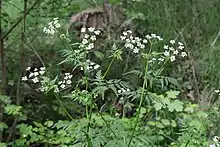Anthriscus sylvestris
Anthriscus sylvestris, known as cow parsley,[2] wild chervil,[2] wild beaked parsley, Queen Anne's lace or keck,[2][3] is a herbaceous biennial or short-lived perennial plant in the family Apiaceae (Umbelliferae),[4] genus Anthriscus. It is also sometimes called mother-die (especially in the UK), a name that is also applied to the common hawthorn. It is native to Europe, western Asia and northwestern Africa. It is related to other diverse members of Apiaceae, such as parsley, carrot, hemlock and hogweed. It is often confused with Daucus carota which is also known as Queen Anne's lace or wild carrot, also a member of the Apiaceae.[5]
| Anthriscus sylvestris | |
|---|---|
 | |
| Scientific classification | |
| Kingdom: | Plantae |
| Clade: | Tracheophytes |
| Clade: | Angiosperms |
| Clade: | Eudicots |
| Clade: | Asterids |
| Order: | Apiales |
| Family: | Apiaceae |
| Genus: | Anthriscus |
| Species: | A. sylvestris |
| Binomial name | |
| Anthriscus sylvestris | |
| Synonyms[1] | |
|
Synonyms list
| |
Description
Cow parsley is an upright herbaceous perennial, growing to 60–170 cm (24–67 in) tall. The stems are hollow, striate, furrowed, and green in colour with flushes of purple with a diameter up to 1.5 cm. It has tiny hairs on the stem, rachis, and leaf stalks which are difficult to see but can easily be detected by touch. The petioles clasp the stem around the base and are broad and flattened with a downy margin. The rachis has a deep grooved channel.
The leaves are triangular, 2-3 pinnate, roughly 30 cm wide and 45 cm long, and green and fern-like feathery in appearance with hair on the underside. The lowest primary division is much smaller than rest of the leaf.[6][7]
The flowers are arranged in compound umbels on short pedicels (<1 cm) with a ring of short, stout hairs at the apex.[8] There are downy oval bractioles with red pointy tips on the umblets, arranged on 4-10 glabrous rays (1.5 - 3 cm long) with no bract present. The ray is hairless, with no bract present. Peduncles are similar in length to rays, more or less glabrous and furrowed. Each flower has 5 white petals, 2 stamens and 2 styles with an enlarged base forming the stylopodium.[9]
Flowering time – April to early June.
Habitat
Cow parsley grows in sunny to semi-shaded locations in meadows and at the edges of hedgerows and woodland. It is a particularly common sight by the roadside. It is sufficiently common and fast-growing to be considered a nuisance weed in gardens. Cow parsley's ability to grow rapidly through rhizomes and to produce large quantities of seeds in a single growing season has made it an invasive species in many areas of the United States. Vermont has listed cow parsley on its "Watch List" of invasive species, while Massachusetts has banned the sale of the plant. It is classed as a Class B Noxious Weed in the State of Washington since 1989,[5] where its sale is also banned. In Iceland, cow parsley has been classified as an alien invasive species.[10]
Uses
All above ground parts of the cow parsley plant are edible, with a flavour sharper than garden chervil and described as grassy parsley with a hint of licorice or aniseed. The root is deemed toxic by some, edible by others. The plant is invasive and spreads easily along roads, and the edges of woods and fields, so it is not cultivated but instead foraged in the wild from February to November. However extreme caution is advised when foraging cow parsley because it is easily confused with other species of the Apiaceae family, such as the deadly poisonous hemlock, hemlock water-dropwort and fool's parsley. Because the plant's flavour is considered unremarkable and the risk is great, foraging cow parsley in the wild is usually strongly discouraged.[11]: 64
Gallery
.jpg.webp) Illustration from Köhler's Medicinal Plants
Illustration from Köhler's Medicinal Plants
 The base of a second-year plant in September and a young layer (Warming 1884)
The base of a second-year plant in September and a young layer (Warming 1884)
References
- The Plant List: A Working List of All Plant Species, retrieved 20 December 2015
- "Anthriscus sylvestris". Germplasm Resources Information Network (GRIN). Agricultural Research Service (ARS), United States Department of Agriculture (USDA). Retrieved 15 December 2017.
- "Cow parsley (Anthriscus sylvestris)". Woodland Trust. Retrieved 2021-06-12.
- Webb, D.A., Parnell, J. and Doogue, D. 1996. An Irish Flora. Dundalgan Press Ltd, Dundalk. ISBN 0-85221-131-7
- "Wild chervil". King County.
- Rose, Francis (2006). The Wild Flower Key. London: Frederick Warne. ISBN 978-0-7232-5175-0.
- Stace, C.A. (2019). New Flora of the British Isles. Suffolk. ISBN 978-1-5272-2630-2.
- Tutin, T.G. (1980). Umbellifers of the British Isles. London: Botanical Society of the British Isles.
- Sell, Peter; Murrell, Gina (2009). Flora of Great Britain and Ireland, vol 3. Cambridge: Cambridge University Press.
- Ágengar plöntur (Invasive plants). Náttúrufræðistofnun Íslands (Icelandic Institute of Natural History. Retrieved on May 2nd 2019. (In Icelandic).
- Renton, Marlow; Biggane, Eric (2019). Foraging Pocket Guide (2020 ed.). Wild Foods UK. ISBN 978-1-9999222-2-1.
External links
| Wikimedia Commons has media related to Anthriscus sylvestris. |
- "Anthriscus sylvestris". Plants For A Future.
- "Wild chervil". Wild Foods UK.